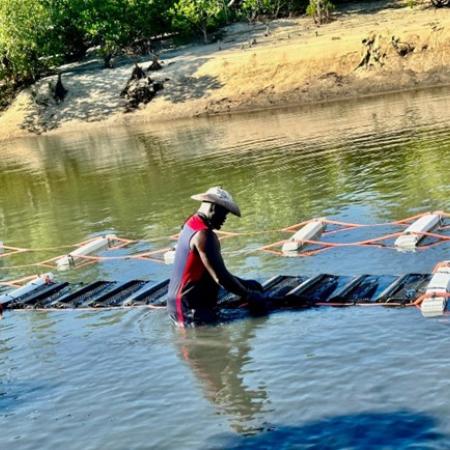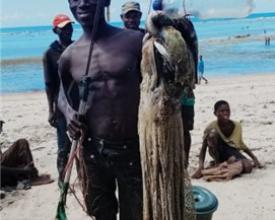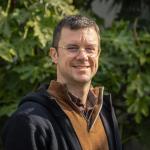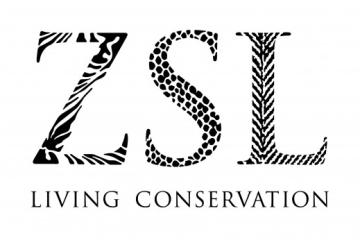
Access of vulnerable community members to income generating bivalve aquaculture in northern Mozambique.

Mozambique is located within the West Indian Ocean and has a coastline of about 2,700 kilometres, composed of sand dunes, remarkable mangrove forests and exceptional coral reefs. It is highly biodiverse and is home to endangered species such as dugongs, sea turtles, dolphins, rays, coral reef fish and sharks.
However, it is exposed to the effects of overfishing and climate change, with cyclones and floods increasing in frequency and intensity, which are significantly degrading coastal ecosystems and reducing marine resources.
The project Our Sea, Our Life (OSOL), aims to strengthen the engagement of communities in the co-management of marine areas in Mozambique. The project also aims to improve the food security and well-being of local communities who are highly dependent on marine resources.
With funding from BIOPAMA, OSOL identified successes and challenges faced by the Locally Managed Marine Area (LMMA) in Bandar, in terms of governance and performance, using the SAGE and IMET methodologies.
Context
Challenges addressed
Socio-economic Challenges
Marine resources provide vital income and food security for vulnerable coastal communities in Northern Mozambique. The province’s inhabitants are among the poorest in Mozambique – over 50% live below the poverty line, and over 80% of people participating in fishing activities with minimal access to other livelihoods. This dependency means high vulnerability to environmental and socioeconomic shocks. This area has also faced intensive migration as thousands have fled unrest in northern Cabo Delgado since 2017.
Biological Challenges
High dependency on natural resources results in mangrove and coral reef degradation from destructive livelihoods (salt ponds, mangrove wood cutting) and unsustainable fishing practices (night and neap tide fishing, destructive fishing gears), alongside natural gas exploitation. Mozambique also suffers extreme natural events like storms and cyclones (exacerbated by climate change), leading to siltation and destruction of marine ecosystems.
Location
Process
Summary of the process
The community focus groups must be well engaged through regular community consultations to address LMMA governance issues and improve LMMA performance. The organization facilitating the focus group meetings should maintain a coherent approach throughout the consultation work with communities to gain trust, incentivize genuine engagement of the community members and resulting in a strong sense of commitment by the community members.
Building Blocks
Training participants in the SAGE and IMET tools.
The first part of this project was training participants on SAGE. To make the SAGE more applicable to our situation, we chose six of the most important principles that are relevant to the LMMA:
1: Respect for resource rights and human rights of community members
3: Effective participation of all relevant actors in decision making
4: Transparency, information sharing and accountability for actions and inactions
8: Equitable sharing of benefits among relevant actors
9: Achievement of conservation and other objectives
10: Effective coordination and collaboration between actors, sectors and levels
The SAGE methodology is a participatory process, conducted with: Community Fisheries Council, fishermen, livelihoods group, community and religious leaders, district and provincial government.
The IMET was supported by two consultants from the National Administration of Conservation Areas. Various actors were invited: a) National Fisheries Administration, Provincial Service of Economic Activities, Provincial Directorate of Environment, Provincial Directorate of Tourism; b) District Service of Economic Activities, Maritime and Lake Police, Administrator of Quirimbas National Park and Justice Authority; c) Community Fisheries Councils, fishermen, community and religious Leaders).
Enabling factors
The two tools, IMET and SAGE, value local knowledge, so the contribution for all actors involved in the process was very positive. It was also a positive process because through this tool, the community understood that management power can be transferred to the community from the government, increasing their sense of ownership and empowerment. Prior to this, the majority of the community thought that the management of the reserves was only for the Conselho Comunitario de Pescass and not for the whole community.
Lesson learned
The good communication and the results of the opening of the temporary reserves (octopus) helped the communities to understand that the reserves belong to the community and are for the benefit of the community, hence neighbouring communities have started to request the project to create new conservation areas.
Stakeholder identification and analysis/site profile analysis.
Analysis and identification of actors/stakeholder:
In order to understand the stakeholders in the project area, all actors in the district who are capable of supporting the establishment of LMMAs were ranked by capacity to contribute to its implementation. The ranking was from 1 to 3 points (1 – low, 2 – medium and 3 – high). Only the stakeholders that had a score of 3 points were selected, namely, government, Community Fisheries Council, fishermen, fisherwomen, influential members (community and religious leaders) and alternative income generating activities groups.
Stakeholders were then engaged through the SAGE/IMET methodologies, through the introduction and background workshops and through partaking in the assessments themselves.
Profile of the study sites:
Characterization of the study site which includes the type of habitat we are protecting, the species, the type of reserve we are implementing which are temporary and permanent reserve (temporary for short-lived species, in this case octopus and for the purpose of increasing household income, and permanent reserve or restocking for biodiversity conservation for generations to come, but the same may cause overflow of fish into the area where fishing is allowed) dimensions of the reserves, legal framework.
Enabling factors
Key enabling factors in this building block include involving project team members who have a strong and in-depth understanding of the communities and landscapes within which we work to ensure that all stakeholders are identified and then ranked correctly. Additionally, it is important to have a wide representation of team members to have an increased range of opinions on stakeholders’ capacity to implement LMMAs and how best to engage them.
Lesson learned
In order to ensure smooth data collection among the focus groups and stakeholders it is important to (i) have clear questions and make sure the issues were well perceived by everyone, (ii) take into account the time required for translations when necessary, and (iii) enable the expression the divergence of opinion. Furthermore, the multi-stakeholders consultation (featuring the presentation of IMET and SAGE assessments’ results) needed to be repeated several times to get buy-in from all stakeholders for elaborating the enhancement plans to improve the LMMA co-management plans.
Participatory Assessment
Data Collection, Data Analysis and Data Synthesis:
Organised groups of actors from different social backgrounds gathered for this process, which was facilitated using the local language and a translator was engaged to assist with the translation. To take into account the level of education of participants, we defined the appropriate means of communication. People participated according to the same interest group or social status (Community Fishery Council, fishermen, fisherwomen, government, influential members and income generation alternatives, among them). In the first phase, discussions were done separately and later discussed in plenary; after the discussion participants reached consensus, it is this consensus that was considered as the final response. To ensure that the selection of members taking part in each target group was inclusive, it did not take into consideration party affiliation, religion, social level, gender. During the meetings we also explained the importance of the SAGE process.
Enabling factors
FPIC standards (Former Prior Informed Consent) must be applied to maximise genuine participation. The data collection/facilitator team should be well known by the community members and recognised as trustful. There should be a sense of long-term engagement in support of the community.
Lesson learned
One of the lessons learned was to present the results of the issues discussed separately in a plenary, where members of different groups discuss the same ideas and reach consensus.
A sign that we are valuing local knowledge.
And that is good for the success of a community-managed conservation area.
Use of data for decision-making and planning.
SAGE Findings:
- Little involvement of fisherwomen in LMMA decision-making, discriminated against because of mosquito net fishing.
- Lack of recognition of community rights to participate in LMMA decision-making.
- Major deficiencies in the process of complaints and follow-up of cases related to invasion of the reserves by the entire community due to the lack of inspection instruments.
- Deficit of collaboration and coordination, it does not share reports and plan of activities between different actors.
Recommendations:
- Involve mosquito net fisherwomen at all stages of LMMA establishment and prioritize opportunity costs for them.
- Disseminate information on rights to participate in LMMA decision-making to all community.
- Encourage community to report offenders and follow up on cases related to the invasion of the reserves.
- Promote regular meetings to share reports and activity plans between actors.
Based on these recommendations, the project is implementing bivalve aquaculture, prioritising women’s involvement to address opportunity costs. We are supporting annual district, provincial and national stakeholder meetings. We are supporting CCPs with equipment for improved LMMA enforcement. We are strengthening CCP skills for communication and equitable governance through training by AMA.
Enabling factors
The purpose of this exercise needs to be well understood by the focus group members. It must exist a will to improve existing conditions by the focus groups members and they must recognise change is possible.
Lesson learned
SAGE and IMET methodologies are the simplest, fastest, easiest and cheapest way to evaluate and monitor the progress of a project. Before adopting these tools, the project used only EXCEL to analyse the data, and this was time consuming and expensive as we needed to hire consultants to conduct the surveys. Data analysis and interpretation was also done manually, which too was time consuming.
Impacts
Socio-economic Impacts:
Of the 42 loans allowed in VSLAs (Village Savings and Loans Associations) in the first half of 2023, 25,000.00 MZN was invested in small-scale businesses; 7,000.00 MZN in agriculture; 6,500.00MNZ was used in construction and home improvements. Out of the VSLA savings 49,140.00MZN was spent on building and improving their homes; 33,340.00 MZN in small businesses; 27,090.00 MZN in basic necessities (clothes and food); and 25,900.00 MZN in mattresses. 80% of the VSLAs members are women which make VSLAs very strong tools to empower women socio-economically resulting in their higher engagement in the governance of marine resources, therefore improving the equitable management of marine resources by the Community Fisheries Councils (CCPs).
Biological Impacts:
Community members have reduced dependence on marine resources through increased access to alternative sustainable livelihoods (bivalve aquaculture), also acting as an alternative protein source. This facilitates increased compliance with LMMA regulations such as respecting no-take zones and temporary closures, preventing overharvesting and allowing fish stocks to recover.
Beneficiaries
- Community members.
- District, Provincial and National Government - we assist in the implementing activities that the government struggles to due to insufficient funds.
- National and foreign universities - spaces for internships and research work.
Sustainable Development Goals
Story

In the 1990s most men and women worked in the cotton and sisal factories; hence the number of fishers was small. There was also little variety in fishing gear, and few buyers. From the year 2000, the factories were closed and with the closure of the factories, came high unemployment, and in response, an increase in the number of fishers.
By 2010, the fishing activity intensified; fishermen of all ages appeared (some coming from Tanzania and Nampula Province) and local market and buyers from other communities and foreigners increased. However, with this development, also came destructive fishing practices. Migrant fishermen were fishing at night using petromax, breaking coral reefs to catch the species hidden in the rocks, and using very fine mesh nets that resemble mosquito nets.
The idea of establishing the locally managed marine areas came from the community itself, having watched through radio and television the opening of the other protected areas in other locations. They were also becoming increasingly aware of the reduction in catches over time. Before the arrival of AMA, there were many attempts to establish the protection zones, but they did not work because of lack of funding and methodology for their success. With the arrival of AMA, they could provide the support to ultimately increase the population of fish and motivate the local community to apply conservation measures.
Currently, the Bandar LMMA in the north of Mozambique is a reference at Mozambican level.



